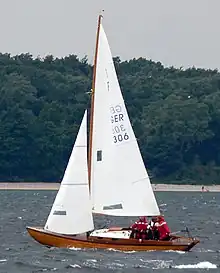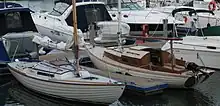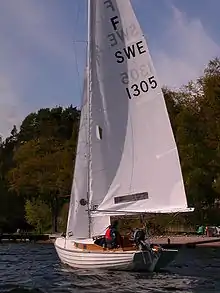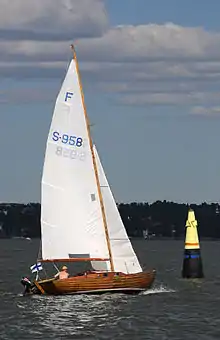F | |
 | |
| Development | |
|---|---|
| Designer | Scandinavian Sailing Federation |
| Location | Nordic countries |
| Year | 1942 |
| No. built | 4,000 |
| Builder(s) | Folkebådcentralen A/S Haubold Yachting |
| Name | Nordic Folkboat |
| Boat | |
| Crew | two to four |
| Displacement | 4,255 lb (1,930 kg) |
| Draft | 3.92 ft (1.19 m) |
| Hull | |
| Type | monohull |
| Construction | wood or fibreglass |
| LOA | 25.20 ft (7.68 m) |
| LWL | 19.68 ft (6.00 m) |
| Beam | 7.22 ft (2.20 m) |
| Engine type | optional Outboard motor |
| Hull appendages | |
| Keel/board type | modified long keel |
| Ballast | 2,205 lb (1,000 kg) |
| Rudder(s) | keel-mounted rudder |
| Rig | |
| Rig type | Bermuda rig |
| I foretriangle height | 18.04 ft (5.50 m) |
| J foretriangle base | 6.72 ft (2.05 m) |
| P mainsail luff | 28.71 ft (8.75 m) |
| E mainsail foot | 11.10 ft (3.38 m) |
| Sails | |
| Sailplan | fractional rigged sloop |
| Mainsail area | 159.34 sq ft (14.803 m2) |
| Jib/genoa area | 60.61 sq ft (5.631 m2) |
| Total sail area | 219.95 sq ft (20.434 m2) |
| Racing | |
| D-PN | 103.2 |
|
| |
The Nordic Folkboat is a sailboat that was designed by Scandinavian Sailing Federation as a racer-cruiser and first built in 1942. Tord Sundén was hired by the Scandivian Sailing Federation to finalize the plans based on four awarded entries in the design competition. The awarded designs were done by Knud Olsen, Jac M. Iversen, Alfons Kvarnström, and O.W. Dahlström.[1] No winning design was declared. Tord Sundén was never credited as the actual designer of the boat.[2][3][4]
The Nordic Folkboat was developed into the Sundén-designed International Folkboat in 1967. The International Folkboat was expressly designed for fibreglass construction. The International 25 and the Olsen 26 are also based upon this design.[2][4][5]
The Junior Folkboat designed by Erik Salander[6] actually dates from 1929. It was originally called the "Juniors Bad" (Junior boat), but was later renamed because of its strong resemblance to the later and larger Nordic Folkboat.[7]
Production
The design has been built by a number of different builders since the first were built in 1942 using wooden clinker construction.[2][4]
By the mid 1970s, timber costs and competition from modern fibreglass boats meant that the folkboat sales were dwindling. Fibreglass versions of the traditional timber folkboat were created by Erik Andreasen and Sven Svendsen. They were molded to the exact dimensions and contours of the traditional clinker hull as well as having the same weight and weight distribution. By 2001, more than 950 glass reinforced plastic (GRP) folkboats had been built.[8]
In the mid-2000s it was being built by Folkebådcentralen A/S of Denmark, but that company seems to be no longer in business. Today the boat is built by Haubold Yachting in Germany.[2][4][9][10][11]
Design

In 1941, while most of Europe was immersed in the Second World War, Sweden was neutral. The Royal Swedish Sailing Association decided to hold a competition to choose a design for a new keelboat, with the support of Swedish shipping magnate Sven Salén, who had won a sailing bronze medal in the Six Meter class at the 1936 Summer Olympics held on the Bay of Kiel. Salén promoted the competition and it attracted 58 designs. The judges could not decide on a winner, instead naming six boats as all having some good attributes. As a young naval architect, Sundén was tasked by Salén with taking the best features of each design and drawing plans for a new boat that incorporated them all in the new design. The plans were published without a designer credited. Construction of the first boat was commenced at Arendals yard in Gothenburg in October 1941 and was launched the next spring, on 23 April 1942. Sundén later claimed the design as his own, but the committee disagreed on that point. Until the time of his death at age 90 in 1999, Sundén was still trying to establish his claim to the credit and the royalties for the design and the matter has never been fully resolved.[12][13][14]
The Nordic Folkboat is a recreational keelboat, that was initially built using wooden clinker construction. It was later produced in fibreglass, with wooden trim, with the fibreglass hull simulating the clinker board construction. It has a fractional sloop rig with wooden spars. The hull has a spooned, raked stem, a sharply angled transom, a keel-mounted rudder controlled by a tiller and a fixed modified long keel, with a cut-away forefoot. Typical versions displace 4,255 lb (1,930 kg) and carry 2,205 lb (1,000 kg) of iron ballast.[2][4]
The boat has a draft of 3.92 ft (1.19 m) with the standard keel and may be fitted with a small outboard motor for docking and manoeuvring.[2]
Some boats have sleeping accommodations for cruising, while others have minimal interiors, optimized for lightness for racing. Cruising-equipped boats often have sleeping accommodation for four people, with two main cabin bunks and a forward "V"-berth.[4]
The design has a Portsmouth Yardstick DP-N racing average handicap of 103.2 and is usually raced by two to four sailors.[4]
Variants
Numerous variants of the basic design have been built.[15] The hull shape was largely retained, with variants being built in fibreglass, with new cabin and deck layouts and sometimes a revised keel shape.[16]
- International Folkboat
- The Swedish Yard of Marieholm Bruk commissioned the original designer Tord Sundén to redesign the boat for fibreglass construction. The International Folkboat appeared in 1969 and became known in Europe as the Marieholm IF Boat. Fibreglass construction was used to create a more graceful profile, more interior space and a larger sail area was added for better light air performance.[17]
- Marieholm 26
- A modification of the IF boat, also designed Tord Sundén and built by Marieholm Boats between 1976 and 1987.[18] A further modification was the Marieholm 261 which was produced by Marieholm from 1982 to 2002 and featured a slightly wider beam.[19]
- Contessa 26
- A British folkboat variant, it was drawn in 1965 by Jeremy Rodgers, who had built Folkboats for a number of years, and David Sadler. They took the classic Folkboat, modified the keel, added more sail area forward for better racing performance, changed the layout and deck structure, and built it from fiberglass instead of wood.[20]
- Stella
- Designed by the yacht designer CR (Kim) Holman in 1959, this boat was made to the requirements of a customer who had seen the Nordic Folkboat. He thought that the English east coast needed a similar vessel, but modified for the North Sea, as opposed to Baltic conditions and also a competitive handicap racer.[21]
Operational history


The boat is supported by an active class club that organizes racing events, the Nordic Folkboat International Association. It has national branches in Sweden, Denmark, Germany and Australia. There are also fleets in Finland, Latvia, Estonia and the San Francisco Bay area of the United States. By 1994, 110 boats were reportedly being sailed in the US.[2][4][22]
In a 1994 review Richard Sherwood wrote, "the boat is noted for its seaworthy character. With an iron keel, it has raced in winds of 40 knots and often carries full sail in 20-25. Most boats have two bunks, and perhaps a vee-berth forward, with camping gear used for cooking. There are lockers. The interiors are apt to vary widely, with some minimized for racing, and others adapted for cruising."[4]
A review in Classic Boat magazine by Steffan Meyric-Hughes wrote, "it has been described as a nautical Volkswagen Beetle. It has been hailed as a rare example of a good thing designed by a committee. But it's more: the Folkboat is the most popular, successful and influential sailing yacht of all time. It comes in various guises and has spawned several derivatives, but the Nordic Folkboat is the original."[23]
A review by Theo Rye in Classic Boat said, "she has seakindly manners that punch far above her modest weight, and her deep cockpit and nicely balanced feel on the helm all add up to a simple but satisfying boat to really sail."[13]
Practical Sailor magazine described the boat in 2010, saying, "the Nordic Folkboat, a clinker-built sloop with a reverse transom, a spoon bow, and a low cabin that gave it simple but pretty lines. Its long keel, slack bilges, barn-door rudder, and hefty ballast ratio (just over 50 percent) equipped it for North Sea adventures. The cockpit however—because it was not self-bailing—raised the risk quotient for any offshore ambitions. The 7/8-fractional rig gave it a conservative sail-area displacement ratio of 16.28. The length-to-beam ratio was just under 3.5. The four-foot draft appealed to the shoalwater challenged. Headroom was ideal for those wonderful creatures of Scandinavian folklore: elves."[14]
Dieter Loibner described the boat in Soundings in 2017 as "a descendant of the sturdy Viking ships, a wind's bride that knows how to handle Erasmus’ moods".[12]
Danish sailor, Paul Elvstrøm, said "At first nobody seemed to like them. It took a while for people to figure out how seaworthy these boats actually are and how well they perform when it is rough."[8]
See also

.jpg.webp)
Similar length sailboats
- Beachcomber 25
- Bayfield 25
- Beneteau First 25.7
- Beneteau First 25S
- Beneteau First 260 Spirit
- Bombardier 7.6
- Catalina 25
- Catalina 250
- C&C 25
- Cal 25
- Cal 2-25
- Capri 25
- Com-Pac 25
- Dufour 1800
- Freedom 25
- Hunter 25.5
- Jouët 760
- Kirby 25
- Kelt 7.6
- O'Day 25
- MacGregor 25
- Merit 25
- Mirage 25
- Northern 25
- Redline 25
- US Yachts US 25
- Watkins 25
References
- ↑ "Historia | Kansanvene - Folkbåt - Folkboat - Suomen kansanveneliitto - Finlands Folkbåtsförbund". www.folkkari.net. Retrieved 21 November 2023.
- 1 2 3 4 5 6 7 McArthur, Bruce (2020). "Nordic Folkboat sailboat". sailboatdata.com. Archived from the original on 24 November 2020. Retrieved 24 November 2020.
- ↑ McArthur, Bruce (2020). "Tord Sundén 1909 - 1999". sailboatdata.com. Archived from the original on 24 November 2020. Retrieved 24 November 2020.
- 1 2 3 4 5 6 7 8 9 Sherwood, Richard M.: A Field Guide to Sailboats of North America, Second Edition, pages 126-127. Houghton Mifflin Company, 1994. ISBN 0-395-65239-1
- ↑ McArthur, Bruce (2020). "International Folkboat". sailboatdata.com. Archived from the original on 24 November 2020. Retrieved 24 November 2020.
- ↑ Sea Time Tech, LLC (2022). "Junior Folkboat". sailboat.guide. Archived from the original on 20 July 2022. Retrieved 20 July 2022.
- ↑ McArthur, Bruce (2020). "Junior Folkboat". sailboatdata.com. Archived from the original on 24 November 2020. Retrieved 24 November 2020.
- 1 2 Loibner, Dieter (2008). The Folkboat story : from cult to classic-- the renaissance of a legend. Dobbs Ferry, NY: Sheridan House. ISBN 978-1-57409-334-6. OCLC 857065961.
- ↑ Folkebådcentralen A/S (15 November 2020). "Folkebådcentralen". folkboat.dk. Archived from the original on 29 April 2007. Retrieved 15 November 2020.
- ↑ Parallels Plesk (15 November 2020). "Welcome". folkboat.dk. Archived from the original on 24 August 2014. Retrieved 15 November 2020.
You see this page because there is no Web site at this address.
- ↑ Haubold Yachting GmbH. "Folkboat Centrale: Ihr Folkeboot-Händler". folkeboot-centrale.de. Archived from the original on 8 August 2020. Retrieved 15 November 2020.
- 1 2 Loibner, Dieter (16 June 2017). "Simple and sound, the Folkboat turns 70". Soundings magazine. Archived from the original on 22 October 2020. Retrieved 15 November 2020.
- 1 2 Rye, Theo. "Why the Folkboat is the most popular cabin yacht of all time: a design analysis". classicboat.co.uk. Archived from the original on 11 November 2020. Retrieved 24 November 2020.
- 1 2 estaff (21 December 2010). "International Folkboat – a Classic Pocket-cruiser: Used Boat Review". practical-sailor.com. Archived from the original on 1 November 2020. Retrieved 24 November 2020.
- ↑ Meyric-Hughes, Steffan (23 August 2018). "Affordable Classics 7 - the Nordic Folkboat". Classic Boat Magazine. Archived from the original on 24 June 2022. Retrieved 19 July 2021.
- ↑ Boat, Classic (9 October 2015). "Why the Folkboat is the most popular cabin yacht of all time: a design analysis". Classic Boat Magazine. Archived from the original on 3 April 2022. Retrieved 19 July 2021.
- ↑ "International Folkboats (IF-Boats) – St Mawes Sailing Club". www.stmawessailing.co.uk. Archived from the original on 26 March 2022. Retrieved 19 July 2021.
- ↑ "Marieholm 26". Sailboat Guide. Retrieved 19 July 2021.
- ↑ Boatim. "Marieholm 261 for sale". Boatim Inc. Archived from the original on 20 July 2022. Retrieved 19 July 2021.
- ↑ "Contessa 26". Cruising World. Archived from the original on 19 July 2021. Retrieved 19 July 2021.
- ↑ Rye, Theo (21 February 2017). "Great yacht designs 10 - the Stella". Classic Boat Magazine. Archived from the original on 19 July 2021. Retrieved 19 July 2021.
- ↑ McArthur, Bruce (2020). "Nordic Folkboat International Association". sailboatdata.com. Archived from the original on 24 November 2020. Retrieved 24 November 2020.
- ↑ Meyric-Hughes, Steffan (15 November 2020). "Affordable Classics 7 – the Nordic Folkboat". Classic Boat. Archived from the original on 20 September 2020. Retrieved 15 November 2020.